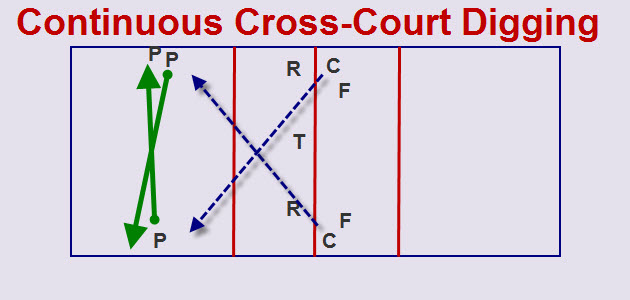Synopsis: Continuous cross-court digging is a high-intensity drill which builds mental toughness while working on individual digging and fitness.
Age/Skill Level: This is a drill for all age groups and skill levels.
Requirements: Three players in the drill, two coaches, 6 or more players to collect balls and feed, lots of balls
Execution: Begin with one player in defense for position 5, and two players queued up behind. A coach positioned on a box in position 4 on the other side of the net hits a cross-court ball at the player which they have to dig to target. The player then sprints across the court to defensive position 1 where they dig a ball from a coach on a box in position 2 on the other side of the net. At the same time, the second player in line in position 5 steps in and digs a ball from the coach in position 4. The players continue going from back and forth digging in positions 1 and 4 until they collectively reach a predetermined objective of X number of good digs.

Variations:
- Depending on the skill level of your team you could only count digs to Target 1 (a 3-pass), or you can accept digs to Target 2 off the net near the 3 meter (a 2-pass).
- To work on keeping digs on their side of the net, you can give a -1 if there’s an overpass. Don’t go negative, however.
- To get players focused on digging with proper technique and being prepared, you can do a -1 for single-arm digs.
- The temptation may be to go with more than 3 players in the drill, but that will likely prove challenging because of the players getting tangled up moving back and forth. Even with 3 players the players are often dodging each other on the cross-over.
- If the players are capable, they can replace one or more of the coaches as hitters.
Additional Comments:
- Keeping the tempo high is a key to this drill. This means the players collecting and feeding balls must be highly efficient. Or you need to have sufficient balls to overcome this deficit.
- Make sure players crossing the court do so away from the net rather than toward it. Otherwise they are at risk of taking a ball in the head.
- Do not let the players give less than 100% effort. If a ball drops with no attempt to play it they go back to 0.
- Don’t alter the rhythm of the hitting once you get going. That will force the players to continue moving rapidly and not slow their pace. This helps them put the last play behind them.
- Make sure the players go all the way to the sideline and don’t stop well inside the court, especially as they tire. You can do this by aiming your hits to land near the sideline, which will keep them honest.
- Talk to the players throughout the drill. Remind them to get to the right spot, to move quickly, and to use good technique. Encourage them throughout, and make sure the rest of the team does so as well.
- Encourage players of similar skill to go together so you can adapt the tempo and aggressiveness of your hits to be able to challenge all players at a level suitable to their development.
- In almost all cases, players have the hardest time with balls attacked to their net side – so their left if they are in Position 5. Those are the ones most likely to end up in over-passes.
- Having players hit rather than coaches offers challenges and advantages (see my ball initiation post). Using coaches likely means better control of the ball and tempo. Player attacking, though, means more realistic balls and work on control for the hitters. You just have to make sure players rotate through, as it can be a lot of swings.